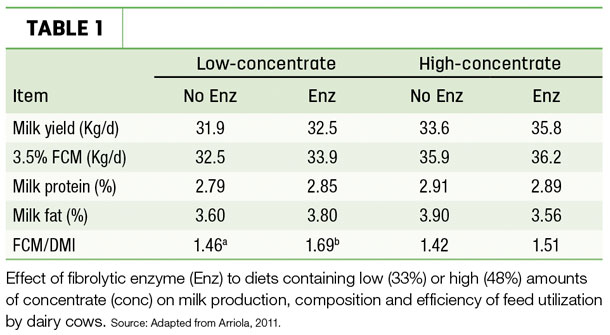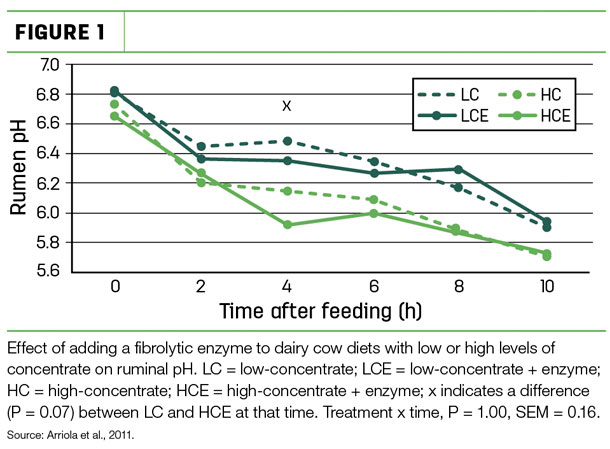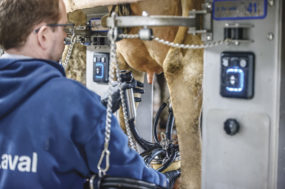Given the ever-rising costs of feedstuffs and the tight margins in the livestock industry, animals need to be as efficient as possible at extracting nutrients out of feeds used in livestock operations. Enzymes are one of the tools that can be used to increase the efficiency of nutrient utilization.
Enzymes are specialized proteins that perform specific functions and make life possible. Enzymes assist or improve chemical reactions (catalyze) that result in the breakdown of organic compounds into substances animals, and microbes, can use as nutrient sources.
Enzymes are very specific in the reactions they catalyze, like a key is specific to the lock it will unlock.
Many of the enzymes needed to break down feedstuffs are produced naturally by microbes in the digestive tract of the animal. However, there are often limitations in the quantity of enzymes produced naturally by the animal for the digestion that occurs in the digestive tract under production conditions.
The rate at which digesta passes through the digestive tract may be too fast for the native enzymes to complete the task of breaking down all of the nutrients consumed by the animal. Additionally, there may be limitations on the amount of enzymes produced by the microbes in the digestive tract due to a digestive upset such as rumen acidosis.
When enzyme products are fed to ruminant animals, the main site of action is the rumen. Enzymes assist the rumen microbial population by performing some of the digestion for the microbes.
Overall, this means improved digestion in the rumen and less work for the rumen microbial population, thus sparing energy that would normally go to the microbes for work and can now go back to the animal for maintenance and production. The improved digestion provides the opportunity to maintain or improve ruminant performance on less dry matter intake.
The enzymes utilized in feed additives are extracted from complex microbial fermentations of fungi (e.g., Aspergillus, Trichoderma) and bacteria (e.g., Bacillus). The micro-organism itself is discarded, since these typically are spoilage micro-organisms.
The type of enzyme and its activity is dependent on the strain of micro-organism used, the media they are grown on and the culture conditions used.
Research has demonstrated that production responses to feeding enzymes can be variable. However, the strategic utilization of enzyme supplements can increase the efficient utilization of the feedstuffs consumed by livestock and the profit potential of the producers who use them.
A single enzyme product will not get the job done, since many different enzymes are required to degrade the structural carbohydrates naturally found in plant cell walls. Therefore, simply adding enzymes to diets without considering the substrates being fed will create variation in the results obtained.
Researchers in 2007 reported an extract containing alpha-amylase activity quadratically increased average daily gain in beef finishing cattle with either cracked corn or high-moisture corn and corn silage – but had no effect with alfalfa hay, cottonseed hulls or steam-flaked corn.
As enzyme technology becomes more popular, attention at the farm level will need to be on the type and dose of enzymes being fed. Researchers in 2011 reported on five doses of a fibrolytic enzyme fed to dairy cattle. These researchers demonstrated that fat-corrected milk efficiency improved as the dosage of the fibrolytic enzyme was increased up to 11.3 percent.
Researchers in 1997 fed an enzyme blend (xylanase and cellulase) to steers and found feed efficiency improved on a barley-based diet yet remained unchanged on a corn-based diet. However, enzymes need time in the rumen to work before they are exposed to the low pH and pepsin of the abomasum.
Forages and other feed ingredients treated with an enzyme-containing product are the foundation for efficiency in ruminant animals. A good forage treatment program will not only preserve the forage treated but also provide enzymes (cellulases, amylases, xylanases and pectinases) that start a “pre-digestion” of fibers, starches and sugars in forages, which makes them more digestible for animals.
The release of sugars from both structural and non-structural carbohydrates stimulates rapid microbial growth, which aids in microbial colonization of plant material. Treating feed directly with enzymes should be considered the first step toward feed efficiency with enzyme technology.
It is important to keep in mind that adding enzymes to ruminant diets will increase the rate of digestion but not necessarily the extent of digestion. This means the effect of enzymes is not due to making substrates digestible if they would not be digested in the rumen without the use of enzymes.
Instead, enzymes capture more value from components of feedstuffs already digestible by allowing quicker release of the nutrients. In this way, more potentially digestible substrates from feed can be obtained for use by livestock.
Knowing the analysis of ingredients used to formulate a diet for ruminants is not only important in understanding what enzyme complex may be best to use but also to understand potential rate-limiting steps. Lignin forms complexes with carbohydrates in the cell wall of plants.
This “interference” from lignin will prevent some enzymes (e.g., xylanase) from binding with their substrate, thus slowing the rate at which enzymes can function. Researchers in 1990 demonstrated that surface area (particle size) is also a major limiting factor, especially for cellulose digestion.
Researchers in 2011 studied the effect of applying a fibrolytic enzyme to diets with high (48 percent) or low (33 percent) amounts of concentrate on milk production of lactating dairy cows. The fibrolytic enzyme increased the fat-corrected milk efficiency of cows fed both the low- and high-concentrate diets, demonstrating the enzyme was functional and capable of improving the digestive efficiency in the rumen, even with lower ruminal pH.
Fermentation of starch in high-concentrate diets leads to depression of rumen pH, predisposing cows to ruminal acidosis. This is demonstrated in Table 1 from the 2011 trial.

Practically speaking, enzymes become advantageous when you consider digestion efficiencies decline with increasing dry matter intake. There is a 4 percent decline in digestion per multiple of maintenance dry matter intake (NRC, 2001).
This occurs because higher intakes generally increase passage rate and reduce the residence time of feed in the rumen for digestion (Figure 1). This process causes intakes to increase to assist the cow in consuming enough energy as digestibility decreases.

Conversely, if one improves digestibility of a TMR with enzymes, cows should not need to consume as much feed to support a given volume of milk production. The reduction in dry matter intake will enhance dry matter digestibility in the rumen due to slower passage rate (increases rumen retention time) of the feed through the rumen.
If dry matter intakes do not decrease with the addition of enzymes, the enhanced digestion by the enzymes can supply more nutrients and energy for increased milk production, even though rumen retention time of feed is compromised by a higher dry matter intake.
Therefore, enzyme technology can improve feed efficiency in three possible ways: direct improvement in digestion of feeds, indirect improvement in digestion via lower dry matter intake and increased rumen retention time of feed, or some combination of the first and second.
Feed efficiency is an important aspect of livestock production. Exogenous enzymes can provide a means to improve efficient use of nutrients in feeds by livestock, enhancing production goals. Starting with the application of a forage/feed inoculant containing enzymes should be considered.
Choosing which enzymes to include should be based on the diet being fed. If done correctly, enzymes can improve the efficiency of livestock production. ![]()

-
David Jones
- Agri-King Inc.
- Email David Jones






